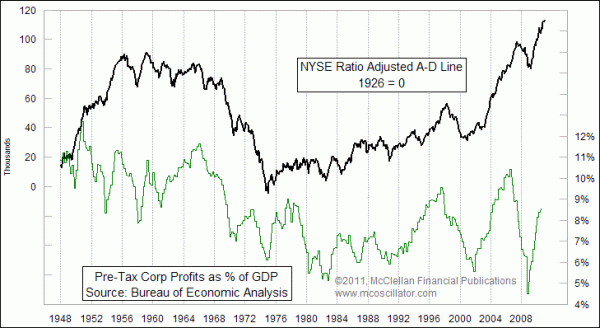Why Even Fundamental Analysts Should Watch A-D Line

Free Chart In Focus email
Delivered to you every week
Back in October 2009, I showed this same chart to point out the real relationship between earnings and the stock market. If you want to know whether overall earnings are going to go up or down, then studying individual balance sheets may be misleading. A better way is to watch the NYSE's Advance-Decline Line.
The A-D Line broke out to a new all-time high back in December 2009, and has continued to push higher. In response, earnings have continued to come in stronger as predicted by the A-D Line upward movement.
A lot of analysts like to examine the combined earnings of SP500 or Russell 1000 companies, since those big companies will account for a big chunk of the total dollars earned. The data in this chart is compiled differently, using data from the Bureau of Economic Analysis for "Corporate profits with inventory valuation and capital consumption adjustments, domestic industries". It can be found in line 17 of the table here. So it includes corporate profits data on not just publicly traded companies but also a broader cross-section of the economy.
These data on profits still have the one big flaw that the public companies' earnings data have, which is that we have to wait until after the end of a quarter for the numbers to be tallied up and reported. So the data in this chart are only current through the end of the 3rd quarter of 2010, which is the latest that are available.
At the point when we see the A-D Line top out and refuse to make higher highs, then we can start to worry about earnings halting their recovery as well. So far there is no sign of that. We might also begin to worry if we see this measure of corporate profits get up above 9%, because that seems to be an important level above which tops are found. Perhaps that is because when companies start getting a lot more profitable, then either GDP picks up to change the denominator of that ratio, or else the folks in Washington, DC start thinking of other things to do with those profits besides allowing companies to keep them.
Under those conditions, we should also expect the Fed to abandon its overly easy monetary policy, which it ought to abandon anyway to avoid committing economic malpractice. But the Fed always overshoots with its actions, so the FOMC is not likely to raise short term rates until signs of inflation are painfully obvious. And while that excessive stimulus will ultimately be bad for inflation, causing the Fed to have to overshoot the other way, for the moment it is very stimulative to stock prices, and thus (eventually) to earnings.
Tom McClellan
Editor, The McClellan Market Report
Oct 16, 2009
A-D Line Has the Story on Corporate Profits |
Jan 01, 2010
Nasdaq A-D Line “Divergence” |
Oct 08, 2010
Strength in Hi-Yield Bonds is Bullish For Stocks |